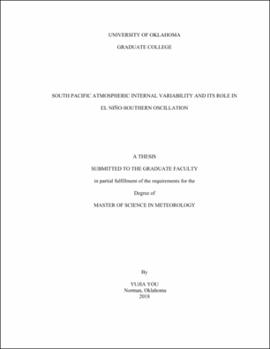| dc.description.abstract | Accurate long-range seasonal prediction of the El Niño-Southern Oscillation (ENSO) phenomenon is of critical importance to predict regional and global climate anomalies. The overarching goal of this work is to seek the extratropical precursors for ENSO events with a focus on the South Pacific. More specifically, this work investigates the impacts of the South Pacific atmospheric internal variability on the occurrence, intensity, evolution, and flavors of ENSO events in the context of the coupled atmosphere-ocean system.
In general, both the tropically forced and intrinsic atmospheric variability in the South Pacific features a large-scale meridional sea level pressure (SLP) dipole with anomalies out-of-phase between the middle and high latitudes. The dipole is termed the South Pacific Oscillation (SPO) in the present thesis. The internal component of the SPO initiates the South Pacific Meridional Mode (SPMM), which acts as an effective conduit transmitting the extratropical wind and sea surface temperature (SST) anomalies (SSTA) into the central-eastern equatorial Pacific via the wind-evaporation-SST (WES) feedback. Modulated by the seasonal cycle of the oceanic mixed layer depth and the lower amplitude of the mean seasonal cycle in the Southern Hemisphere, the WES feedback involved with the SPMM is most effective during the austral summer, providing a favorable timing for the SPMM to prime an ENSO event. The SPMM-induced anomalies in the central-eastern tropical Pacific interfere constructively or destructively with the contemporaneous western tropical anomalies driven by the North Pacific Meridional Mode (NPMM) to shape the occurrence, evolution, amplitude, and potentially the longitudinal position of the maximum SSTA associated with ENSO events. Both the Pacific meridional modes are most efficient at triggering ENSO events when the subsurface equatorial Pacific Ocean is preconditioned with the anomalous heat content buildup. The NPMM and SPMM during the austral winter (February-May) operate as skillful predictors for the boreal winter SSTA in the Pacific basin.
Despite considerable improvements to long-lead forecasts of ENSO activity over the past decades, the model prediction of the ENSO flavor is constrained to about one-to-two season lead time. Our results indicate that the austral winter SPO appears to be a primary source contributing to uncertainty in ENSO forecasts and provides important implications for the seasonal prediction of the ensuing ENSO flavors. Specifically, the spatial structure and amplitude of the austral winter SPO are considerably regulated by atmospheric intrinsic process, which affects the strength of the South Pacific subtropical high, forces stochastic zonal wind stresses and regulates discharge of the ocean heat content in the eastern equatorial Pacific. Although the wind stress relevant to the internal variability decays rapidly, it initiates coupled instability that grows into ENSO-like structure by the Bjerknes feedback. Given that internal variability is, by definition, unpredictable even with a perfect model, the austral winter SPO might serve as a natural limit for ENSO prediction.
Collectively, the current study highlights the importance of the South Pacific atmospheric internal variability and provides potential enhancements to understand and predict ENSO events. The findings contribute to the existing literature on the connection between North Pacific and ENSO to include the South Pacific. Although this thesis primarily focuses on the interannual variability, the role of the SPMM in Pacific decadal variability and its connection to ENSO under anthropogenic climate change warrant future investigations. | en_US |
